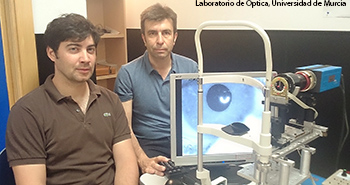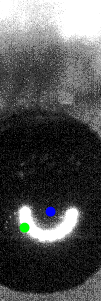
Juan Tabernero (left) and OSA Fellow Pablo Artal with their experimental setup.
As humans shift their gaze thousands of times each day, their eye movements cause the crystalline lenses to wobble back and forth—just as a serving of gelatin, poked with a spoon, shivers until its oscillations damp out. For a few tens of milliseconds after each eye movement, our vision is degraded, perhaps due to the lens wobbles—the exact mechanism is still not fully understood.
Using a high-speed camera, two Spanish scientists have filmed these quivering lenses in healthy human subjects and found that they act like classical damped-harmonic oscillators (PLoS One, doi:10.1371/journal.pone.0095764). The studies could help future researchers study disorders of the lens and eye muscles.
According to Juan Tabernero and OSA Fellow Pablo Artal, optical scientists at the University of Murcia, humans make up to 60,000 small eye movements, called “saccades,” daily to keep objects in their field of view. Not only do images blur during the saccades, but also for roughly 50 ms after the eye stops moving. The moving eyeball generates kinetic energy, which gets transferred to the eye muscles, orbit and interior structures.
Tabernero and Artal shone infrared LED light into their subjects' eyes and asked them to move their gaze in specific vertical and horizontal directions. With the high-speed camera, the scientists recorded the so-called Purkinje images, or reflections of exterior objects from the cornea and lens of the eye.

This animated GIF shows the tracking of the first Purkinje image (corneal reflection) marked with a white filled circle while tracking of the fourth Purkinje image (lens posterior surface reflection) is marked in green. Crystalline lens reflection (fourth Purkinje image) wobbled for a fraction of a second after the saccadic movement.
Computer modeling results revealed that the lens wobbles occurred with a natural frequency of 15 to 20 Hz, an average amplitude of 191 μm and a damping ratio of 0.3 to 0.7. Downward eye movements created larger-amplitude lens oscillations than upward eye movements, but horizontal saccades generated the largest-amplitude wiggles.
The average time constant of the lens oscillations, 65 ms, exceeds the post-saccadic vision suppression time constant of 50 ms, so healthy humans don't notice any blurring from their temporarily wobbly lenses.
